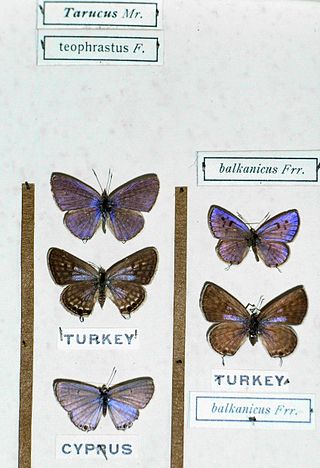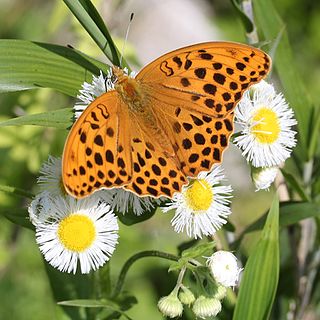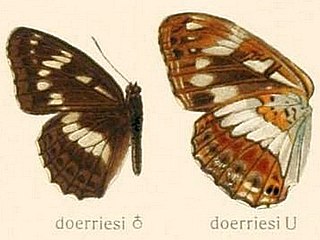
Colotis danae, the crimson tip or scarlet tip, is a small butterfly of the family Pieridae, that is, the yellows and whites. It is found in Asia and Africa.

Delias pasithoe, the redbase Jezebel is a medium-sized butterfly of the family Pieridae, that is, the yellows and whites. The species is found in parts of South Asia and Southeast Asia. There has been some dispute for which species the specific name aglaja, used twice by Linnaeus in 1758, applies – the redbase Jezebel, or the dark green fritillary, a brush-footed butterfly. Here, Delias pasithoe is used for the redbase Jezebel, based on the replacement name proposed by Linnaeus himself.

Appias lalage, the spot puffin, is a small butterfly of the family Pieridae, that is, the yellows and whites, which is found in India, Indochina and Hainan.

Appias indra, the plain puffin, is a small butterfly of the family Pieridae, that is, the yellows and whites, which is found in south and southeast Asia.

Tarucus theophrastus, the common tiger blue, pointed Pierrot or African Pierrot, is a small butterfly found in the Old World tropics. It belongs to the lycaenids or blues family.

The purple-edged copper is a butterfly of the family Lycaenidae.

Parnassius stubbendorfi is a high-altitude butterfly found in from the Altai Mountains across central, south, and far east Siberia, Sakhalin and the Kuril Islands and from Mongolia across north China to west Korea and Japan (Hokkaido). It is a member of the snow Apollo genus (Parnassius) of the swallowtail family (Papilionidae).

Parnassius felderi, the Felder's Apollo, is a high-altitude butterfly which is found in Amur, Ussuri and China, North Korea and Japan. It is a member of the snow Apollo genus (Parnassius) of the swallowtail family, (Papilionidae).

Calliteara pudibunda, the pale tussock, is a moth of the family Erebidae. The Dutch common name for the moth (Meriansborstel) comes from the butterfly and insect painter Maria Sibylla Merian. The species was first described by Carl Linnaeus in his 1758 10th edition of Systema Naturae. It is found in Asia and Europe.

Dicallomera fascelina, the dark tussock, is a moth in the family Erebidae. The species was first described by Carl Linnaeus in his 1758 10th edition of Systema Naturae. It is found in most of Europe, through the Palearctic to Central Asia to Korea.

Favria is a monotypic genus of spread-wing skippers in the butterfly family Hesperiidae. This genus was formerly a synonym of Muschampia, and its only species, Favria cribrellum, was formerly a member of Muschampia. The species is commonly known as the spinose skipper.

Catochrysops strabo, the forget-me-not, is a small butterfly found in Asia that belongs to the lycaenids or blues family. The species was first described by Johan Christian Fabricius in 1793. It is found in Sri Lanka, India, from Sikkim to Indochina and in Sundaland, Sulawesi and the Philippines.

Muschampia proto, the sage skipper, is a butterfly of the family Hesperiidae. It is found in Morocco, Algeria, the Iberian Peninsula and southern France.

Muschampia tessellum, the tessellated skipper, is a butterfly of the family Hesperiidae. It is found from the southern Balkan Peninsula through Ukraine, southern Russia and Asia Minor, southern Siberia, Mongolia, east to the Amur region.

Catopyrops ancyra, or Felder's lineblue, is a species of butterfly belonging to the lycaenid family described by Cajetan Felder in 1860. It is found in the Indomalayan and Australasian realms.

Euphydryas intermedia synonym ichnea is a small butterfly found in the Palearctic that belongs to the browns family. It occurs up to 2200 m above sea level.

Coenonympha amaryllis is a small butterfly found in the East Palearctic that belongs to the browns family.

Argynnis anadyomene is a butterfly found in the East Palearctic that belongs to the browns family.

Limenitis doerriesi is a butterfly found in the East Palearctic that belongs to the browns family.

Limenitis homeyeri is a butterfly found in the East Palearctic that belongs to the browns family.




















